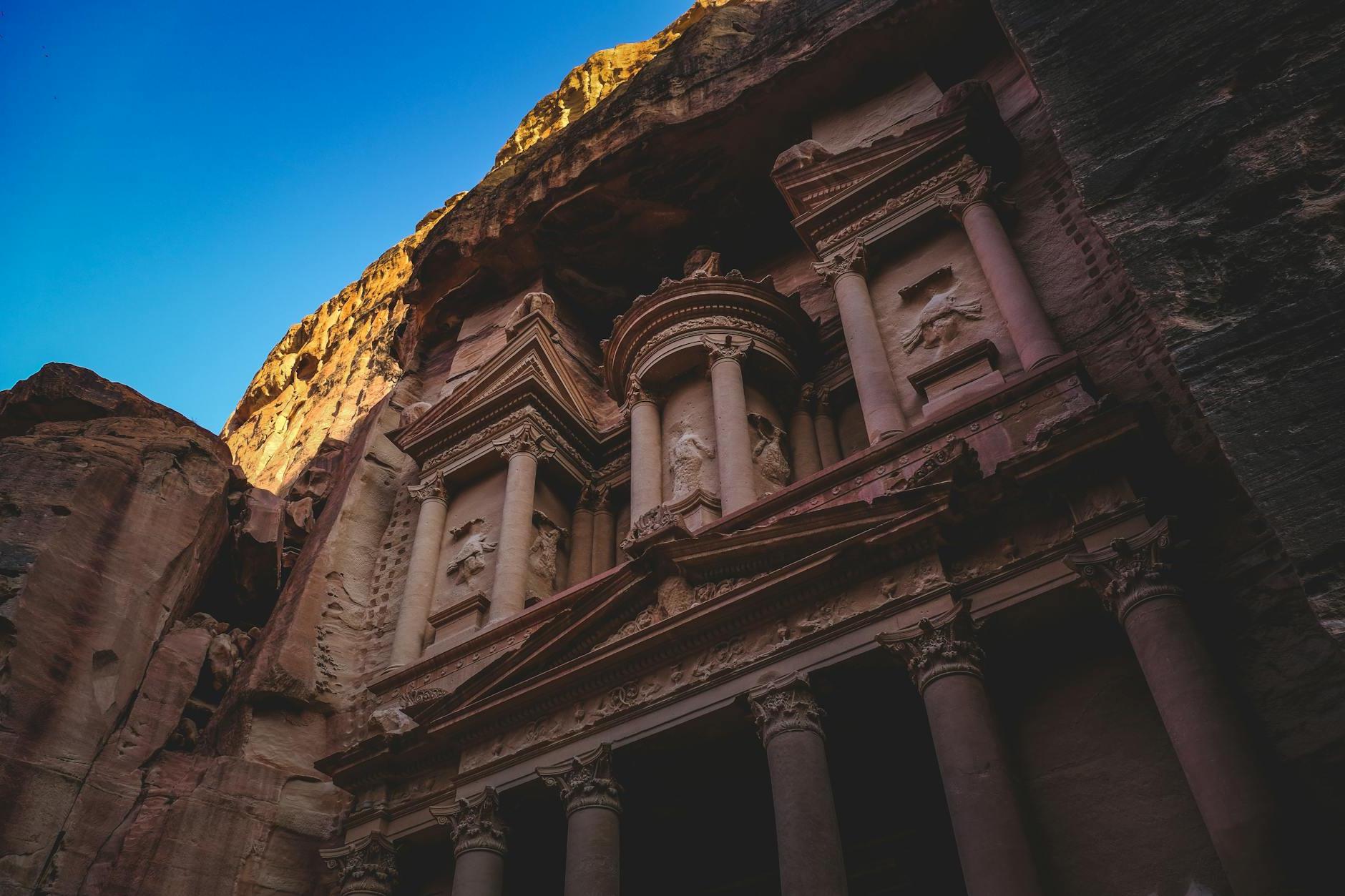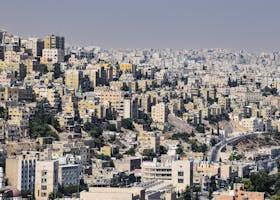Top 10 Must-See Spots in Petra, Jordan
Posted on June 4, 2024 • 10 minutes • 1989 words
Table of contents
Journey to the heart of Jordan and discover Petra, a city carved from rose-red rock that captivates travelers from around the globe. Known as the “Lost City,” Petra’s wonders are best explored during the pleasant spring and autumn months when the weather is mild and inviting. Yet, no matter the season, Petra’s timeless beauty and rich history promise an unforgettable adventure. Dive into our list of the top 10 must-see spots in Petra and uncover the magic that awaits you in this ancient city.
10 best things to see in Petra
10. The Siq
When visiting Petra in Jordan, you definitely should explore The Siq, the narrow gorge that serves as the main entrance to this ancient city. To get there, you can start your journey from the Petra Visitor Center, which is just a short walk to the entrance of The Siq. This pathway is about 1.2 kilometers long, with towering red sandstone walls that create a dramatic and unforgettable entrance. As you meander through The Siq, which can be as narrow as three meters in some places, you’ll notice intricate carvings and remnants of ancient water channels that hint at the engineering prowess of the Nabateans. Pay close attention to small niches carved into the rock; these were once used for religious offerings. At the end of The Siq, you’ll be rewarded with your first breathtaking view of the Treasury, Petra’s most iconic structure. This journey sets the stage for the wonders that lie ahead and fills you with anticipation and awe.
9. High Place of Sacrifice
When you visit Petra, the High Place of Sacrifice is a must-see spot. This ancient site offers breathtaking views of the whole city of Petra, making it a great place for photos. To get there, you’ll need to follow a steep path that starts near the main Petra gate. The hike takes about an hour, so wear comfortable shoes and bring water. Along the way, you’ll see beautiful carvings and unique rock formations. When you reach the top, you’ll find altars used for ancient rituals. The climb might be challenging, but the panoramic views and the sense of history make it worth the effort.
8. Little Petra
When you visit Petra, don’t miss the chance to explore Little Petra, a charming and quieter escape just a few miles away from the main site. Little Petra offers a more relaxed experience, with fewer crowds and equally stunning rock-cut architecture. You’ll find beautiful frescoes and small hidden chambers that give you a glimpse into the ancient Nabataean lifestyle. To get there, you can take a short taxi ride from Petra, or even join a local tour that includes both sites. Once you arrive, wear comfortable shoes and bring plenty of water, as the terrain can be uneven and the climate quite warm. Enjoy the serenity and unique charm of Little Petra!
7. The Great Temple
When you visit Petra, The Great Temple is a must-see! This ancient structure showcases the impressive architectural skills of the Nabataeans. As you explore the temple, you’ll be amazed by its detailed carvings and grand columns. To get there, follow the main path from the entrance of Petra, which is about a 30-minute walk. Keep an eye out for the large staircase leading up to the temple. Don’t forget to wear comfortable shoes, bring water, and plan your visit during the cooler parts of the day, as it can get quite hot. Enjoy the history and beauty of this incredible site!
6. Royal Tombs
When you visit Petra, the Royal Tombs are a must-see! These huge, ancient burial sites carved into the rose-red cliffs are a stunning example of Nabatean architecture. To get there, start at the Siq, the narrow gorge that leads into Petra, and walk past the iconic Treasury. Continue along the main path until you see the large, impressive facades of the Royal Tombs on your right. Key tombs to note are the Urn Tomb, Silk Tomb, and the Corinthian Tomb. Each one has its unique features and history. Wear comfortable shoes, bring water, and don’t forget your camera to capture the incredible details!
5. Petra Church
When you visit Petra in Jordan, make sure to see Petra Church. This ancient site offers beautiful mosaics and a glimpse into the region’s early Christian history. To get there, follow the main path from the Siq, pass the famous Treasury, and continue toward the Royal Tombs. The church is a bit off the main route, so look for signs pointing to it. Pay special attention to the stunning floor mosaics that depict various animals and geometric patterns. Also, enjoy the peaceful atmosphere away from the busier parts of Petra. Be sure to wear comfortable shoes and bring water, as the walk can be tiring but is entirely rewarding.
4. Street of Facades
When you visit Petra, make sure to explore the Street of Facades. This remarkable pathway is lined with tombs and houses carved into the rock by the ancient Nabataeans. The intricate carvings and the sheer scale of the architecture give you a glimpse into Petra’s fascinating history. To reach the Street of Facades, enter Petra through the Siq, a narrow gorge that leads you to the iconic Treasury. From there, follow the main trail deeper into the city. Keep your eyes open for detailed carvings on the facades, and don’t miss the chance to step inside some of the tombs to see even more stunning workmanship. It’s a journey back in time that you won’t forget!
3. Al-Khazneh (The Treasury)
Visiting Al-Khazneh (The Treasury) in Petra is a must-do for anyone traveling to Jordan. This ancient marvel, carved directly into a sandstone cliff, is one of the most iconic sights in the world. To get to Al-Khazneh, you’ll need to walk through the Siq, a narrow, winding gorge that adds to the anticipation and excitement. The walk through the Siq is about 1.2 kilometers (0.75 miles) and offers stunning views of rock formations along the way. Once you reach The Treasury, be ready to be amazed by its intricate carvings and towering facade. Don’t forget to look up at the detailed sculptures and take your time to appreciate this architectural wonder. Also, visit early in the morning or late in the afternoon to avoid crowds and capture the best light for photos.
2. The Monastery (Ad-Deir)
When you visit Petra, make sure not to miss The Monastery (Ad-Deir), one of its most stunning sites. It’s a massive rock-cut building that offers breathtaking views and a sense of awe with its grandeur and history. To reach The Monastery, you’ll need to hike up around 800 well-marked steps from the city center. The hike can take about 45 minutes to an hour, depending on your pace. Along the way, you’ll encounter charming stalls and amazing viewpoints, so keep your camera handy. Wear comfortable shoes and carry water because the journey can be tiring but worth it. Once you arrive, the impressive size and beauty of The Monastery will make every step worthwhile.
1. The Petra Theatre
When you visit Petra, make sure to explore the Petra Theatre, an ancient wonder carved directly into the rock. This grand amphitheater, built by the Nabataeans, can hold up to 8,500 spectators and offers a glimpse into the city’s rich history. To get there, start at the Siq, the narrow gorge that leads to Petra’s Treasury. From the Treasury, follow the main trail along the Street of Facades. The Theatre is about a 10-minute walk from the Treasury. As you visit, pay attention to the intricate details of the rock carvings and the natural acoustics of the theatre. Also, be cautious of the uneven ground and wear comfortable walking shoes. Don’t forget your camera—this is a sight worth capturing!
Frequently Asked Questions
1. What is the best time of the year to visit Petra?
The best time of the year to visit Petra is during the spring (March to May) and autumn (September to November). During these months, the weather is mild and comfortable, making it perfect for exploring this incredible ancient city. The temperatures are not too hot, which is ideal for walking and sightseeing. If you visit in the spring, you’ll also get to see the desert flowers in bloom. Alternatively, the winter months (December to February) can also be a good time to visit as it is less crowded and often more affordable, though it can be quite cold. Summer (June to August) is the least ideal due to the intense heat, but if you can handle the high temperatures, you may find some good deals and fewer tourists.
2. Should I rent a car in Petra?
Renting a car in Petra can be a good idea if you prefer flexibility and comfort. The roads leading to Petra are generally in good condition, but keep in mind that traffic can get busy, especially during tourist season. Parking is available near the Petra Visitor Center, but it can fill up quickly, so arriving early is a smart move. If you’d rather not drive, public buses and shared taxis (minibuses) connect Petra with nearby towns and cities, although they might not be as frequent or convenient. Private taxis are also an option, offering door-to-door service, but they can be more expensive. Weigh your options based on your travel style and budget to decide what’s best for you.
3. What are different ways to get to Petra?
Getting to Petra, one of Jordan’s most famous attractions, can be done in several ways. If you’re flying, the nearest airport is King Hussein International Airport in Aqaba, which is about 100 kilometers away. Queen Alia International Airport in Amman is another option, located roughly 235 kilometers away. From either airport, you can rent a car or take a taxi to Petra. For those who prefer public transport, buses are a convenient choice; the Jordanian company JETT offers direct routes from Amman to Petra. Unfortunately, there are no trains that connect Petra with other cities. If you’re driving, the trip from Amman to Petra takes around 3 hours via the Desert Highway (also known as Highway 15) or the more scenic King’s Highway (Highway 35). From Aqaba, it’s a shorter drive of about 2 hours on the Desert Highway.
4. Are there things to do with children in Petra?
Absolutely, there are plenty of things to do with children in Petra! This ancient city in Jordan is not only fascinating for adults but also has many attractions that will captivate young minds. You can start by exploring the Siq, a narrow and winding path that leads to the famous Treasury building. The walk is exciting for children as they can imagine themselves as explorers. Camel and donkey rides are also a big hit with kids and offer a fun way to see the ancient ruins. Don’t miss out on the Little Petra, a smaller and less crowded version of the main site, which is great for kids who might get tired easily. Lastly, be sure to visit the Petra Museum, which has interactive exhibits that make learning about history fun and engaging for children. So, yes, Petra is very family-friendly and offers lots of enjoyable activities for children.
5. Is Petra safe to travel to?
Yes, Petra is generally safe to travel to. The ancient city, located in Jordan, welcomes thousands of tourists each year without major incidents. While violent crime is rare, it’s always wise to be cautious. Petty crimes like pickpocketing can occur, especially in crowded areas. Keep your valuables out of sight and stay aware of your surroundings at all times. It’s a good idea to use a money belt or a crossbody bag to keep your belongings secure. Be wary of anyone offering deals that seem too good to be true. Just like any tourist destination, following basic precautions will help ensure a safe and enjoyable visit to Petra.




